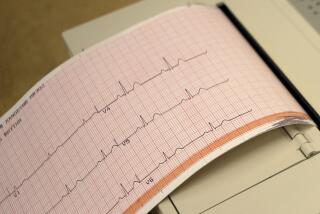The Cutting Edge: COMPUTING / TECHNOLOGY / INNOVATION : Computer-Aided Cancer Predictions
- Share via
A variation on a 27-year-old computer program that was created to help oil prospectors pick the best locations for their wells is now being used to diagnose breast cancer and determine the patient’s prognosis. Although the original aim in modifying the old program, created by researchers at the University of Wisconsin at Madison, was to help diagnose breast cancer, it is now helping researchers go even further: predicting the course of the disease in individual patients.
Getting clues very early as to whether the disease will recur has two benefits. First, it could provide peace of mind for patients by offering a more accurate prognosis--current methods are only a little more than 60% accurate in predicting whether a malignant cancer will recur in five or 10 years. And the program could eventually eliminate the need for surgery to remove lymph nodes under a patient’s arm--currently essential to developing a prognosis.
The computer science researchers, instead of studying the size of the tumor and the presence of the cancer in lymph nodes, have focused on the information derived from a sample of 100 or fewer cancer cells. Key features of these cells--such as the nucleus size, shape and texture--are analyzed by the program and compared against a base of hundreds of known cases. The program is based on what is known as “machine learning,” in which computers can be “trained” to recognize objects, structures and patterns.
Training the computer to recognize objects, structures and patterns is the same approach Olvi Mangasarian, a computer science professor, used when he created his program for oil prospectors. The computer learned which geologic structures showed the most promise. Applications for machine learning are common in the fields of financial investment and robotics. In the future, it could be used to diagnose other diseases as well as breast cancer.
Get the Bugs Out: Pipeline corrosion is a problem the chemical, gas, oil, nuclear and water industries face. The cost of water-treatment chemicals alone to fight corrosion and fouling ran to $1.2 billion last year. In certain cases, the corrosion is actually caused by colonies of bacteria that form deposits on metal surfaces, build layers of slime and produce organic acids that cause pitting. Now Argonne National Laboratory and the Southern California Gas Co. have begun a $1.7-million, three-year project to come up with new detection methods and more environmentally friendly treatments to fight corrosion from bacteria colonies. Chemicals have been largely successful in controlling the problem, but the project hopes to reduce chemical use. Argonne and the Gas Co. will examine different carbon and low-alloy steels to see if metallurgical characteristics influence the bacteria’s ability to attach to metals. They will also look at surface treatments that could make metals more resistant. Field studies will be carried out at a new test facility the Gas Co. has built at its underground gas storage field in Montebello.
Stroke Stopper: A new drug that may limit the extent of brain damage associated with acute stroke is undergoing a major clinical trial at UC San Francisco Medical Center. A stroke occurs when there is a sudden interruption of blood supply to a part of the brain due to a burst artery or a blood clot. Brain tissue, deprived of oxygen, dies within minutes, leading to loss of speech, paralysis, loss of vision or a combination of the afflictions.
More than 500,000 Americans suffer strokes each year. Strokes are the third-leading cause of death and the No. 1 cause of disability in adults in the United States. Although there are medications to prevent secondary stroke, there is currently no effective treatment for an initial stroke.
The UC San Francisco test revolves around pro-urokinase, a modified form of a naturally occurring enzyme that dissolves clots. Pro-urokinase, which works by dissolving cerebral blood clots, is delivered to the brain via a catheter placed in a blood vessel in the groin area and directed to the site of the clot.
If the drug can be delivered within the six hours after a patient experiences stroke symptoms, the drug could limit damage to the brain: The less time the brain is deprived of oxygen, the greater the chance that the brain can recover and a patient’s functions can be restored. The trial is being funded by Abbot Laboratories.






